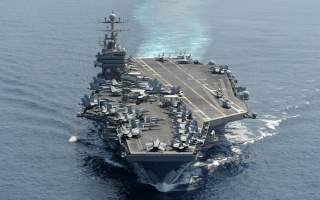Is China Getting Ready to Build Nuclear-Powered Aircraft Carriers?
There is at least some evidence to suggest exactly that.
Could an experimental ship be a prototype for a Chinese nuclear-powered aircraft carrier?
A Chinese company has put out a solicitation to build a nuclear-powered surface ship. While the United States Navy operates nuclear-powered aircraft carriers and submarines, China’s only nuclear warships are submarines. But the People’s Liberation Army Navy is reportedly working on nuclear-powered carriers as it builds up its carrier fleet.
China General Nuclear Power Group, or CGN, designs and builds nuclear power plants for the energy sector. But the company is soliciting bids to build a 33,000-ton vessel that is 152 meters (498 feet) long, 30 meters (98 feet) wide and 18 meters (59 feet) deep, according to the South China Morning Post.
“The ship will be able to be fitted with two 25-megawatt compact pressurized water reactors with thermal power output of 200MW [megawatts], which could propel the ship to a maximum speed of 11.5 knots, according to CGN’s project description,” the newspaper said.
One possibility is that the vessel is just a prototype for a nuclear-powered icebreaker. Russia is the only nation to operate such vessels, as part of a massive forty-one-strong fleet of conventional and nuclear icebreakers. Older, Soviet-era nuclear icebreakers, such as the Taymyr, displace a bit over 20,000 tons. But coincidentally or not, the latest Russian Project 22220 icebreakers—the first may launch this summer—displace 33,000 tons like the CGN design.
As an export-driven economy that depends on shipping, China has every reason to want to build icebreakers. With climate change melting Arctic ice packs, suddenly Russia, the United States, Canada and other nations are eyeing potential new shipping routes that could slash transportation time and costs. China will want to be a player in that game.
Operating in remote polar regions, an icebreaker with a near-infinite fuel supply is valuable. “In June, state-owned China National Nuclear Corporation (CNNC) also invited bids for a nuclear-powered icebreaker project that will be powered by floating small modular reactors,” the South China Morning Post noted.
But nuclear icebreakers could be a prototype for a more lethal kind of ship. Song Zhongping, a military analyst based in Hong Kong, suggested that nuclear icebreakers could serve as testbeds to develop nuclear aircraft carriers.
“This vessel can verify and experiment with the technologies,” he told the South China Morning Post.
“This follows the approach that the former Soviet Union took in its development of nuclear aircraft carriers,” the newspaper said. “The Soviets had built five nuclear icebreakers before cutting steel in 1988 for their first nuclear carrier Ulyanovsk, which was never completed.”
One limitation with using the CGN vessel as a nuclear carrier prototype would be a lack of electrical power. The specification seems to call for two reactors that generate 200 MW of power. The two A1B reactors on a U.S. Ford-class carrier generate 700 MW each, while the two A4W reactors on a Nimitz-class carrier supply 550 MW each. Lack of electricity can hamper a ship’s speed, sensors or even a high-tech electromagnetic catapult to launch aircraft.
Ultimately, it’s one thing to operate a nuclear-powered ship. It’s another to operate a nuclear-powered ship safely. The harrowing stories of Soviet submarines that suffered reactor accidents, such as the notorious K-19 incident, prove that the nuclear genie needs to be carefully contained in his pressurized containment bottle.
The U.S. Navy has been operating nuclear-powered surface ships since 1962, when the aircraft carrier USS Enterprise was launched. So far, the U.S. Navy’s safety record has been exemplary. China has nuclear submarines since the 1970s, but if wants a nuclear surface navy, it’s going to have to start somewhere.
Michael Peck is a contributing writer for the National Interest. He can be found on Twitter and Facebook.
Image: Flickr

